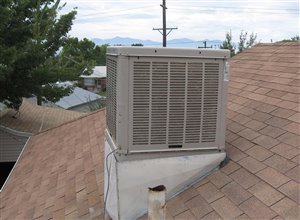Hi
This is going off topic on this forum, I know, but as I am registered with this one and not an A/C forum I thought I might give this a try.
Something different.
I understand the workings of refrigeration and A/C units.
However, there is a "cooler unit" (not described as an A/C unit ) that uses water rather than refrigerant.
Now the principle of A/C units is to move the heat, via the refrigerant, from inside to outside.
The air inside gets recirculated and cooled and dehumidified.
The one that uses water is called an evaporative cooler. There are large commercial and industrial units in hot and dry environments like south west USA where they are used extensively. The reason is they draw in air from outside, which is already cooler that the inside air, cools it and pushes the inside air out through vents. It also humidifies the air with the evaporated water. This is good in environments where the humidity is too low.
However, they are also found as small portable room units in this country.
They work by water soaking a filter. The warm air is drawn in and as it goes through the wet filter the water evaporates transferring the heat from the air to the water thereby cooling the air. In these units the air is recirculated. The expelled air feels cooler than if you run it without water as it will then just act as a fan.
So it works.
Now here's the thing I don't understand. I've watched loads of YouTube videos and none of them explain this, only what I have explained above.
This goes for both types, industrial and small portable.
If the heat transfers from the air to the evaporated water and the evaporate is expelled with the cooled air, the heat being expelled should end up being the same. Why can you feel the cooler air and not the warmed up evaporate? In the case of an industrial unit why does the cooled air cool the area and the warm air not heat the area at the same time canceling each other out?
Hope this has sparked someones interest as a departure from the usual electrical topics.

